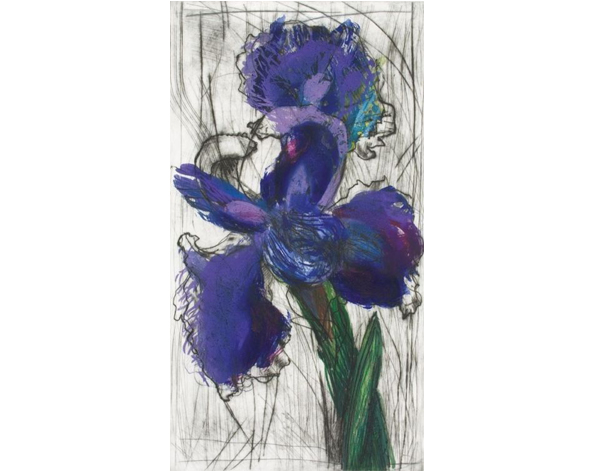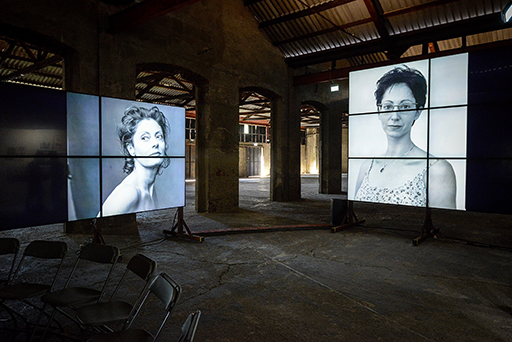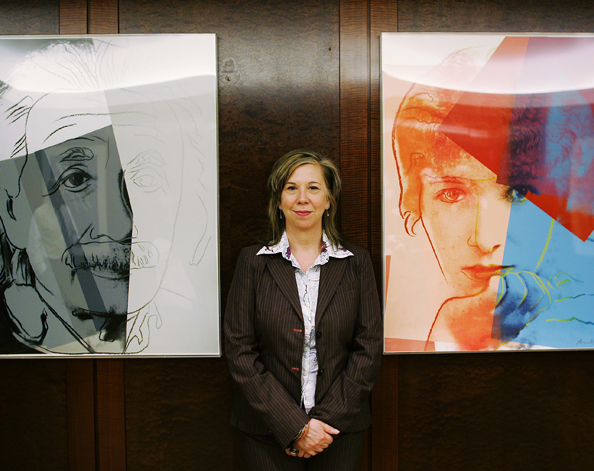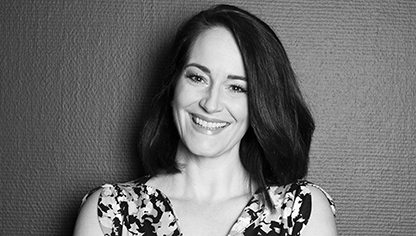Receive Focus insights straight to your inbox
Most importantly, you need to establish why you’re investing in art. You need a clearly articulated strategy that will inform your purchasing choices.
“Corporate curation is more than just having random art on the walls. It’s an active collection that ties into some sort of strategy and purpose,” says Jenni Verschoor Investec Private Banking employee and an MBA student at the Gibs Institute of Business Science at the University of Pretoria whose thesis on corporate art collections was entitled: “Why do companies invest in art? The purpose and composition of art collections in the South African financial sector”.
What to consider when formulating an art strategy
Culture and corporate identity
Corporate collections should operate in strict parameters. The artwork on display is reflective of the company, and inferences are drawn about the company based on the work shown.
Damon Garstang, a curator at Goodman Gallery, explains, “There is hypersensitivity around the choices a corporate curator makes because they need to fall within the ethics and brand consciousness of the company. Choices are made within much stricter boundaries, compared to a private collection. However, it doesn’t mean your collection needs to be dowdy or stale. You can acquire very interesting, cutting-edge work that isn’t overly provocative.”

There is hypersensitivity around the choices a corporate curator makes because they need to fall within the ethics and brand consciousness of the company.
Client entertainment
A collection can be used to promote a certain image through PR events, advertising and client hospitality. “Some companies will create an exhibition and open it to the public, or they can curate a collection on behalf of somebody else. It’s a way of showing off your premises and inviting existing or potential clients to start a conversation,” says Jenni.
Corporate social investment
Businesses may invest in emerging local artists to support and uplift their community. This is often linked to branding and coincides with the company’s CSI strategy. According to Jenni, companies within the financial and legal sector invest specifically in South African and African art, acquiring original works (paintings, drawings, sculptures) to be displayed around the offices.
The purpose of these collections is less about investment and more about supporting young, up-and-coming local artists, uplifting existing artworks and creating a growing awareness among staff of what is current in the local art world.

Corporate curation is more than just having random art on the walls. It’s an active collection that ties into some sort of strategy and purpose.
Investec's corporate art collection
Investec made the decision, 40 years ago, to purchase modern, contemporary, international
art.
From the outset, Investec identified art that was not only modern but international. “This was when we had not yet become an international group. So there was great vision and foresight here, as a precursor to the steps that were subsequently taken to build the business,” said Craig Gunnell, Investec Sandton Facilities head.
"This was when we had not yet become an international group. So there was great vision and foresight here, as a precursor to the steps that were subsequently taken to build the business."
“Investec wanted to be a modern bank, hence its choice of 20th-century art. Bernard Kantor (Group Managing Director) and Stephen Koseff (Group CEO) were clear about what they liked and didn’t like,” said Ethel Kastner, Investec’s art curator.
“Manfred Frier and Leslie Sacks (Les Art International) were at the forefront of Investec’s art buying at the bank’s outset. Investec chose original prints. Even though its first home on Fox Street was a small local bank, the idea was to enhance and beautify the place. Aesthetics were important and on that basis, Investec made its decisions,” said Ethel Kastner.
Forty years on Investec’s art still has a strong international emphasis, but the collection has evolved to allow certain divisions within the bank to purchase their own art for a specific purpose. Some of these works include pieces by celebrated local artists like William Kentridge, Edoardo Villa and Samson Mnisi.

Dutch Iris by renowned South African artist William Kentridge is featured in the Investec art collection
Enhanced workspace for staff
According to Jenni, there’s a lot of research into the employee benefits of having an art collection. Art can be used to educate staff. It can be an effective tool to encourage communication, promote inspiration and innovation. “Art helps you look at things differently, and can shift perspectives and open up creativity. The more you get your staff involved, the more benefit it has. Some businesses will have a website dedicated to their art collection, with the sole purpose of engaging and educating their staff.”
Art as an investment
Interestingly, few corporates collect art chiefly to achieve a return on investment. “This is not a primary motivator for owning an art collection. It’s not part of their primary business. It’s a side aspect that generally falls into interior decor or facilities. So some companies keep a spreadsheet, and they monitor the investment value of pieces, but more as an inventory, rather than for investment purposes.” Regardless, you might want your collection to reflect on your balance sheet depending on its size and worth.
Read more: How good is art as an investment?

Swiss bank UBS commissioned Annie Leibovitz's 2016 collection WOMEN: New Portraits. The UBS Art Collection comprises 32,000 artworks.
Hire a curator or an art adviser
Few businesses will have someone in their employ who has the time or knowledge to make your strategy a reality. Art collection should be an ongoing endeavour after all, so hiring the services of a curator or art adviser is essential.
Damon explains the value of curation: “The notion of curatorship is the idea of looking after something – acquiring and gathering artworks and ordering and displaying them in a way that makes sense - which is accessible, comprehensible and ensures that objectives of your collection are reached.”
As your collection grows, curators have an understanding of the breadth and depth of a collection and make sure each piece justifies its existence.

Deutsche Bank boasts the largest corporate art collection in the world, with over 57,000 artworks.
Getting the most out of your collection
Position, position, position
Where you place an artwork in your office can make or break a piece. “It should be about choosing pieces that have the desired impact for their chosen home,” says Damon. If you have a large-scale artwork that’s several metres high, then placing it in an atrium, for example, so it can be seen from many floors will ensure its maximum impact. But it’s not always size that counts.
“If there’s a small piece that’s sitting in a waiting or reception area that draws you in, that could have the same impact as a work on a larger scale. The pieces must have the right emotive impact for their intended home.”
Increasingly businesses are taking down walls in favour of more open plan office space. But this doesn’t mean art that usually hangs on a wall needs to be sold. In these instances, Damon suggests suspending artworks from ceilings or placing sculptures and objects from the collection in vitrines or on plinths within the space.
Jenni suggests investing in sculpture but says necessary precautions should be taken to protect the pieces against people handling them or bumping them over. If you’re moving into a new office or renovating, consider commissioning a piece specifically for a space.
Rotate, refresh, reframe
An art collection should never be static. Consider moving pieces around your office, and regrouping certain pieces together as this can completely change their impact and meaning. Keeping up to date with displaying trends like framing and mounting ensures your art remains
fresh and up to date.
Rent, retire or sell
To keep your collection interesting, consider adding and removing pieces. If you don’t have appropriate storage space (damp free, dust free, temperature controlled and secure) then retiring a piece to make room for fresh acquisition is a good idea, especially if an artwork is increasing in value but doesn’t fit into your current aesthetic vision. Insurance companies will have strict rules in place for how and where art can be stored.
If you’re in a period of discovery, then renting is a good option. “If you’re not sure what you’re looking for, or you are after variety, then renting art is a good option. You can have it on consignment and then rent it. This allows you to interchange and freshen up your collection. You’re not so worried about the investment value because it doesn’t belong to you.”
"If you’re not sure what you’re looking for, or you are after variety, then renting art is a good option."
So consider renting a piece from a small to mid-end gallery for a few months, and then change it. Get your staff and clients’ opinion on pieces before buying. Sometimes, however, selling the piece is the right move. “A piece may no longer make sense within the broader curatorial vision for your collection and you may want to sell it. If you’ve bought the right work in the first place, it will be readily saleable, and you can use the proceeds from the sale to buy something new that’s a worthy addition to your collection,” explains Damon.
Evolution of corporate collections
Business has become a significant player in the art market and a growing source of revenue for the arts. According to Jenni, post the 2008 global recession, it became increasingly necessary for businesses to become more strategic in how they use their collections and how they align them with their intentions to gain maximum value. Companies may also use their collection for more than one purpose, which adds complexity to the curation of the collection.
According to Jenni, It’s vital for leadership to have a say in the direction of the art collection. “It’s important for all collections to be purposefully managed and driven from the top. This will ensure that it’s being utilised to its full potential and aligns with the strategy of the business.”
While it may seem that there’s a lot to consider before starting a corporate art collection, the many advantages make the exercise a worthwhile one. Moreover, the overall strategy of the collection can change and evolve as the business does. So get started and let your artwork
work for your business.
About the author

Caroline Edey-van Wyk
Brand Editor
Colloquially known as Investec’s “storyteller,” Caroline curates and produces all the content that underpins Investec's Out of the Ordinary brand promise. She works across the business but specialises in the areas of Sustainability, CSI, Sponsorships and HR. Caroline holds a Bachelor of Journalism degree in Political Science and Broadcasting - cum laude. Before she joined Investec she was a broadcast journalist at Sky News and eNCA.




